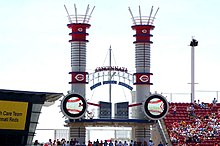The great american ballpark, home to the Cincinnati Reds, is not just a sports venue; it’s a cherished landmark that encapsulates the spirit of baseball. Nestled on the banks of the Ohio River in Cincinnati, Ohio, this ballpark offers more than just a place to watch baseball; it provides an experience rich with history, culture, and entertainment.
History and Construction
The great american ballpark opened its gates on March 31, 2003, marking a new era for the Cincinnati Reds. The stadium was built to replace Riverfront Stadium, also known as Cinergy Field, which had been the Reds’ home since 1970. The construction of the Great American Ball Park was part of a broader initiative to revitalize Cincinnati’s riverfront, integrating modern amenities with nods to the city’s rich baseball history.
Architecture and Design
The design of the great american ballparkGreat American Ball Park was a collaborative effort by Populous (formerly HOK Sport) and GBBN Architects. The stadium boasts a seating capacity of approximately 42,319 and features a blend of traditional and contemporary architectural elements. The great american ballparkpark’s façade is adorned with brick and stone, reflecting the classic ballpark aesthetic, while its sleek, modern lines ensure it stands out as a state-of-the-art facility.
One of the most iconic features of the ballpark is the “Gap.” This unique architectural element is a 35-foot-wide break in the stands between home plate and third base, providing spectacular views of the Ohio River and the Kentucky shoreline. The Gap symbolizes the connection between the city and its baseball heritage.
Fan Experience
Seating and Sightlines
The Great american ballpark was designed with the fan experience in mind. The seating arrangement ensures excellent sightlines from every angle, allowing fans to feel closer to the action on the field. The park offers a variety of seating options, from traditional field-level seats to luxury suites and club seats, catering to different preferences and budgets.
The Fan Zone
The Fan Zone is a family-friendly area located on the first-base concourse. It features interactive exhibits, batting cages, and a play area for kids, making it an ideal spot for families to enjoy pre-game activities. The Fan Zone also houses the Reds Hall of Fame and Museum, which showcases the rich history of the franchise through exhibits, artifacts, and multimedia displays.
The Riverfront Club
For those seeking a more upscale experience, the Riverfront Club offers a premium dining option with breathtaking views of the Ohio River. The club features a diverse menu, including local cuisine and ballpark favorites, providing a perfect setting for entertaining clients or enjoying a special night out.
Notable Features and Traditions
The Smokestacks
One of the most distinctive features of the great american ballpark is the two smokestacks located in the right-center field. These smokestacks pay homage to Cincinnati’s historic steamboat era and play a prominent role in the ballpark experience. When a Reds player hits a home run, the smokestacks emit fireworks and bursts of flames, adding an extra layer of excitement for fans.

The Crosley Terrace
Crosley Terrace, located at the main entrance, is a tribute to Crosley Field, the Reds’ home from 1912 to 1970. The terrace features bronze statues of Reds legends, including Ted Kluszewski, Ernie Lombardi, Joe Nuxhall, and Frank Robinson, capturing iconic moments in Reds history. This area serves as a gathering spot for fans and a reminder of the team’s storied past.
The Power Stacks great american ballpark
In addition to the smokestacks, the great american ballpark is also known for its Power Stacks, two large pillars adorned with LED lights that synchronize with game events. These Power Stacks light up and flash different colors to celebrate home runs, strikeouts, and other significant plays, enhancing the overall atmosphere of the ballpark.
Memorable Moments
Since its opening, the great american ballpark has been the backdrop for many memorable moments in baseball history. One of the most notable events was Ken Griffey Jr.’s 500th career home run, which he hit on June 20, 2004, becoming the 20th player in Major League Baseball history to reach this milestone. The ballpark also hosted the 2015 MLB All-Star Game, showcasing its capacity to host major events and bringing national attention to Cincinnati.
Community and Economic Impact
The construction of the great american ballpark has had a significant impact on the local community and economy. The ballpark has spurred the development of The Banks, a mixed-use development that includes residential units, restaurants, shops, and entertainment venues, revitalizing the riverfront area and attracting tourists and locals alike.
The presence of the ballpark has also led to job creation and increased revenue for local businesses. On game days, the influx of fans supports nearby restaurants, bars, and hotels, contributing to the city’s economy. Additionally, the Reds organization is actively involved in community outreach programs, supporting local charities, youth sports, and educational initiatives.
Conclusion
The Great American Ball Park is more than just a baseball stadium; it’s a symbol of Cincinnati’s passion for the sport and a catalyst for community development. From its thoughtful architectural design to its fan-friendly amenities and rich traditions, the ballpark offers an unparalleled experience for baseball enthusiasts and visitors alike. As the home of the Cincinnati Reds, the great american ballpark continues to be a cherished landmark, celebrating the past, present, and future of America’s favorite pastime.



